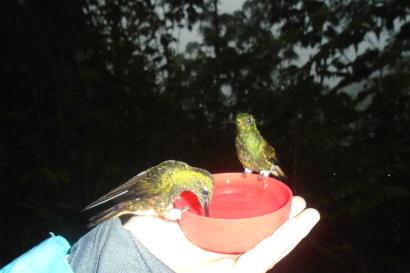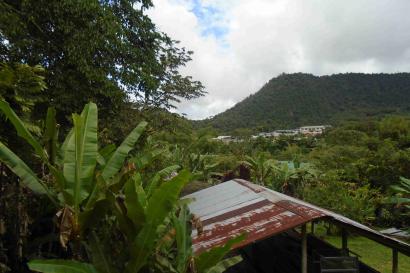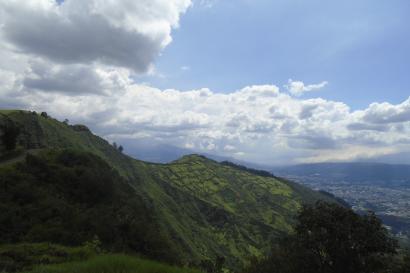Five weeks in Ecuador has taken me to more ecosystems than 20 years in the States. Whether its planning a weekend adventure with my friends or spending hours on a bus with my classmates, I have welcomed the ever-changing landscapes and wildlife.
My first class in the Evolutionary Ecology track was Tropical Ecology. I picked the course because of the field trips, most importantly the Amazon field trip. However, the moment I knew I’d love the course was when my professor, Esteban, informed us that grades weren’t important but the experiences were. Esteban’s class was a relaxed environment with informative lectures, energetic discussions and interacting with nature. Almost everyday we were in the field applying the concepts learned in class to the real life.
The moment I finally understood the meaning of watershed was the two days my class hiked through Río Tipo, a Tropical Montane forest and watershed. Green foliage, thick forest and vast mountains were all around us as we trudged through the heat. Pastures had been cleared for agriculture and grazing. Surprisingly, the steepness that easily affected us humans didn’t faze the cows that made it up the mountain.
At one point, the hiking trail ran close to the edge creating a wide view of the area. Esteban pointed to a mountain that had long scratches of brown and described it as scarred by landslides. His description stuck with me. The mountain showed its resilience and fragility with the scars. The landslides tore through the dense forest on it, but the vegetation was growing back and thriving. The mountain also showed its resilience by operating as a watershed despite the deforestation for agriculture. I was in awe at how one moment I could be standing in a cool forest surrounded by trees and wild ginger and then the next standing in a man-made pasture surrounded by African grass and sun.
Unlike mild-mannered, warm, and lush Río Tipo, Papallacta was cold, muddy, and muted in color. Our hike began in the Super-Páramo, the highest part of the mountain. It consisted of mostly dead grasses, rolling slopes and biting rain. The point of no return was 20 minutes into the five-hour hike. The minimal plants living in the Páramo have spent years adapting to the harsh conditions; we had 20 minutes. I like to joke that it’s the only place to get sunburn and frostbite. I didn’t adapt.
I walked back to the bus, after falling down the mountain in mud, and joined two other classmates who had difficulty adjusting. The decision to quit was one of the best decision we could’ve made. My classmates and I conducted our field work in the Sub-Páramo, the part of the Páramo that shares some characteristics with a Tropical Montane Forest and has the lowest altitude. We followed a hiking trail that populated with Red Angel’s Trumpets and Papel de Arbols.
The Papel de Arbols formed small canopies over the trail and protected us from the rain. Walking underneath them was like entering a different world, even for a short while. The trail eventually led to a forest with a river rushing through. The Sub-Páramo was a stark contrast from the Super-Páramo. It was populated with birds, tall trees and colorful flowers. The Super-Páramo was beautiful in its own way. Beautiful because the plants and animals survive the harsh condition such as strong winds and intense bursts of sunlight every day. Somehow, they’re both the same forest.
At the end of our hike, we lounged in the hotel and drank delicious hot chocolate. The rest of my class arrived while we were warming up by the fire, visibly miserable. Luckily, the three-course lunch and soothing hot springs of Baños won them over.
Tiputini is the best trip in this class. One week exploring the Amazon Rainforest, dining with bats hanging from the ceiling, rooming with geckos or tarantulas on the windows and walking with monkeys swinging from the trees. It was five days in the poster child of biodiversity. The morning my class was to leave, I woke up late at 3:50AM and had 10 minutes to grab my luggage and rush to the university. I was praying that Esteban wouldn’t leave me behind and I miss the trip of a lifetime, and a week of class.
The trip to Tiputini is a full day commitment. There is a 30-minute bus ride to the airport, a 45-minute plane ride to Río Coca, a 10-minute taxi ride to the pier. At the pier, there is a one-hour board ride to a security checkpoint. From there we take a one-hour chiva (truck) ride to another boat. In two hours, we finally arrive at the Tiputini Bio station.
I highly recommend staying awake on the last boat ride. Sleeping on this boat might mean missing the wildlife in and near the Tiputini River. I was sitting in front of the boat watching the shoreline pass by when the guide tells us to hurry to the back. A river dolphin was following behind boat and had surfaced for air. A frenzy onboard ensued. Everyone rushed to grab their cameras to take pictures or video. The elusive dolphin would disappear just as quickly as it surfaced. The atmosphere sparked with excitement when someone managed to make a sighting.
Shortly after ogling over the dolphin, we arrived at the Tiputini Biostation. This city girl was going to spend the next five days living in the jungle.

Tony Harris
<p>I attend Loyola University Chicago and am majoring in environmental science with a chemistry minor. When I’m not studying, I’m planning events and handling communications for the Student Environmental Alliance club. This has included cultivating previous journalism experience into scientific literature or publications. I try to keep busy with internships and campus events.</p>
<p>Besides academics, I enjoy being with friends and unwinding with video games, a book or TV. My favorite games are multiplayer and I binge watched Orange is the New Black in two days. I love being out in nature and try to go on adventures.</p>








